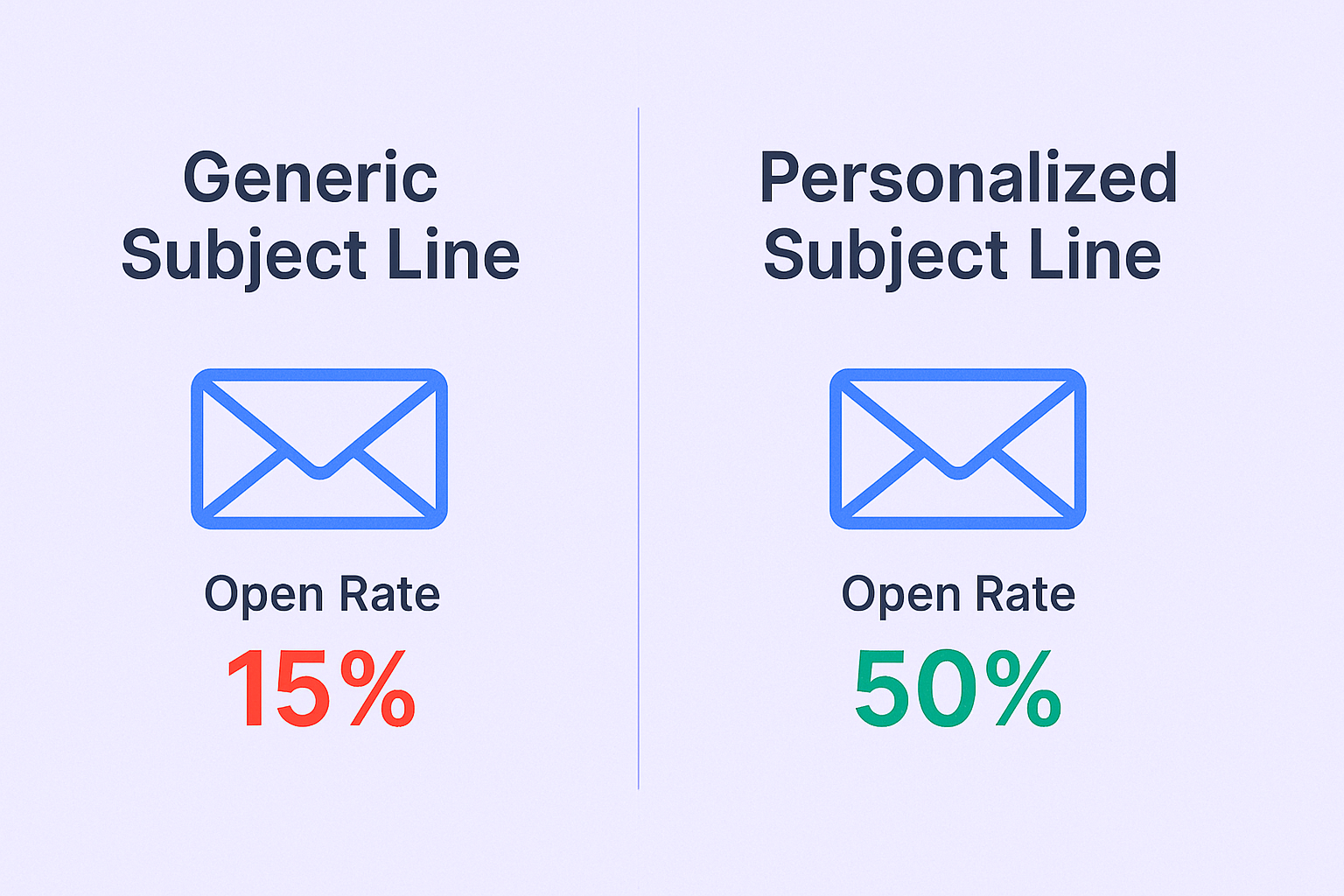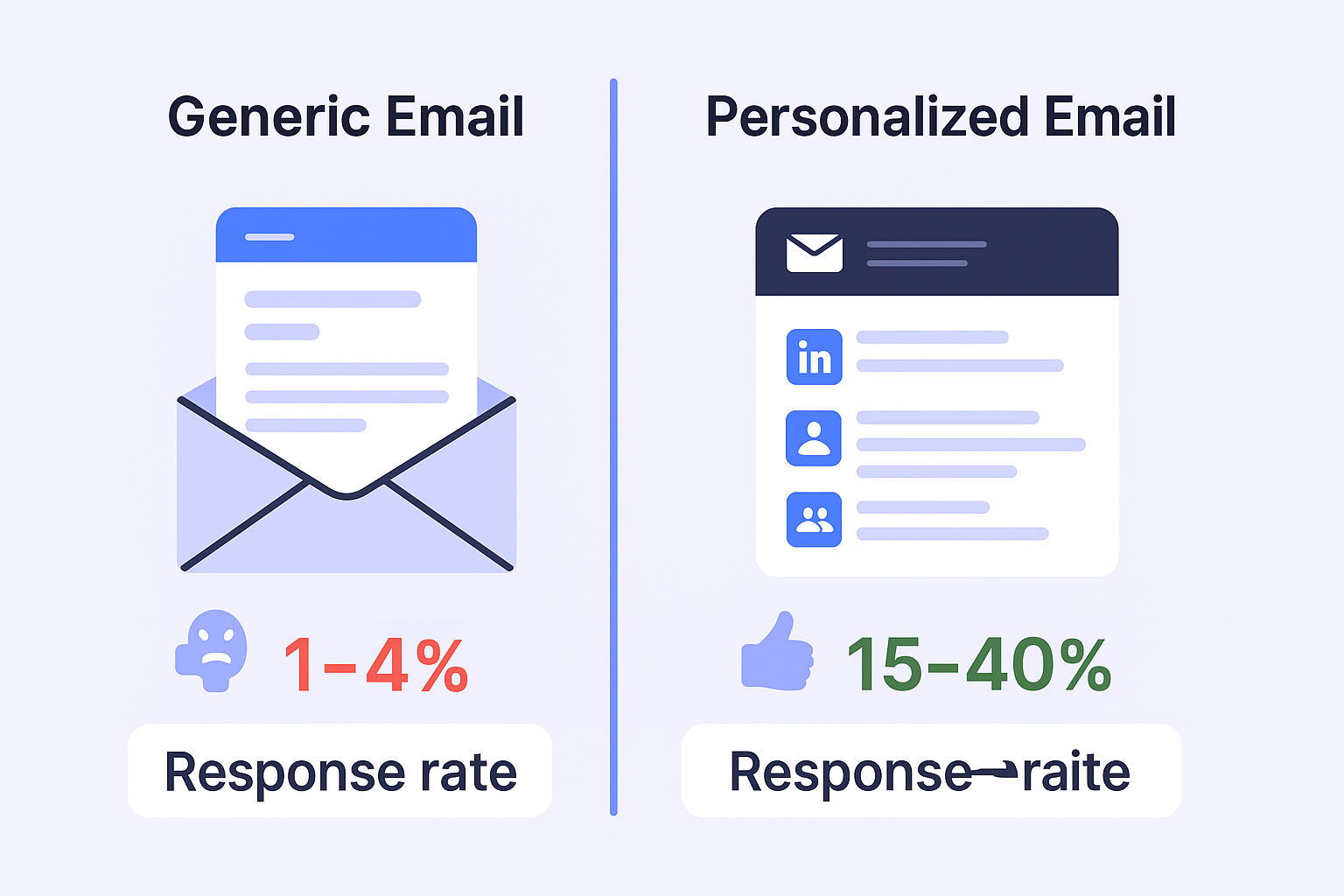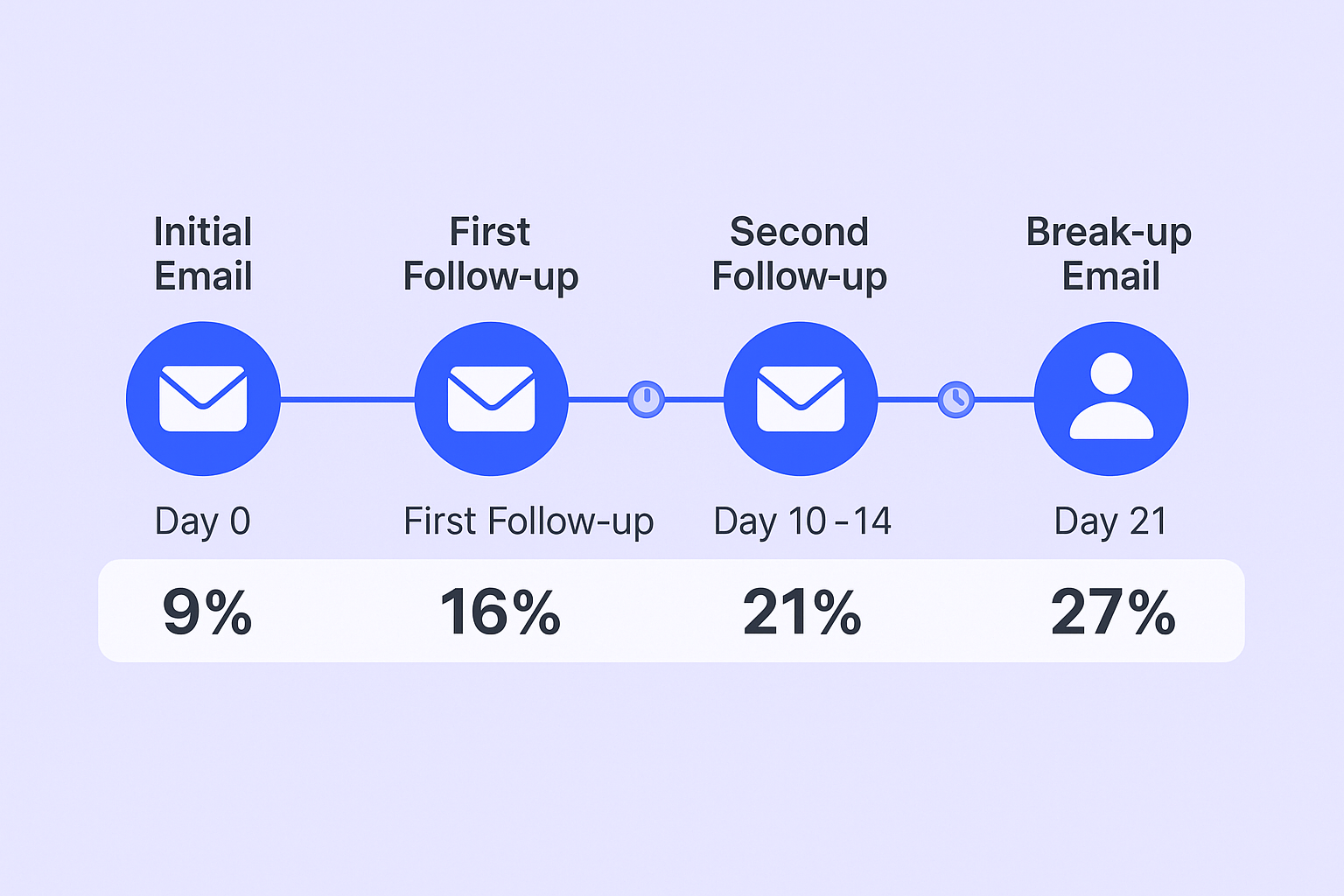- blog
- Cold Emailing
- Cold Email Lead Generation: 7 Proven Strategies That Work in 2025

Cold Email Lead Generation: 7 Proven Strategies That Work in 2025
Table of Contents
Let’s be honest – your inbox is probably flooded with cold emails right now. And if you’re a BDR or AE, you’re likely sending them too. But here’s the thing: the average reply rate is only 1–4%, which might make you wonder if cold email lead generation is even worth your time anymore.
The reality? It absolutely is. While most cold emails fail miserably, the ones that succeed are crushing it. 78% of companies use email marketing to generate leads, and there’s a good reason why. When done right, cold email delivers an impressive ROI of $42 for every $1 spent.
The secret isn’t sending more emails – it’s sending smarter ones. In this guide, we’ll walk you through 7 proven strategies that separate high-performing cold email campaigns from the noise. Whether you’re just starting out or looking to optimize your existing approach, these tactics will help you generate more qualified leads and book more meetings.
What is Cold Email Lead Generation?
Cold email lead generation is the process of reaching out to potential customers who haven’t had any prior contact with your business through personalized email messages. Unlike email marketing, which targets subscribers who’ve opted in, cold emailing involves contacting prospects who might not even know your company exists yet.
This approach has become crucial for business growth. 85% of marketers say lead generation is their top measure in 2024, and cold email remains one of the most cost-effective methods to achieve this goal. For BDRs and AEs, it’s often the primary way to fill the sales pipeline with qualified opportunities.
What makes cold email particularly powerful is its scalability and targeting precision. You can reach decision-makers directly, bypass gatekeepers, and deliver your message when it’s convenient for the prospect to consume. Plus, with proper execution, cold email campaigns can generate impressive returns – cold email marketing has a 2x higher ROI than cold calling or trade shows.
The key difference between successful and failed cold email campaigns lies in the execution. While anyone can blast generic messages to thousands of prospects, effective cold email lead generation requires strategy, personalization, and a deep understanding of your target audience.
Pay Attention to Subject Lines
Your subject line is make-or-break for your entire cold email campaign. Think about it – 47% of recipients open emails based solely on subject lines, with 69% reporting messages as spam for the same reason. That’s a massive responsibility resting on just a few words.
Here’s what actually works: personalization. Personalized subject lines generate 50% higher email open rates compared to generic ones. But we’re not talking about just slapping someone’s name in there. The most effective subject lines include specific details about the prospect or their company.
Length matters too. Subject lines between 36 and 50 characters generate the highest response rates, giving you enough space to be descriptive while staying mobile-friendly. And here’s a pro tip: including the prospect’s company name in the subject line improves open rates by 22%.
Some subject line approaches that consistently perform well:
- “Quick idea for [Company Name]”
- “Thoughts on [specific challenge they’re facing]?”
- “[Mutual connection] suggested I reach out”
- “Noticed [recent company news/achievement]”
The key is making your subject line feel like it was written specifically for that person, not like it came from a mass email blast. Avoid spam triggers like ALL CAPS, excessive punctuation, or overly salesy language that screams “delete me.”
Remember, your subject line’s job isn’t to sell – it’s to get the email opened. Save the pitch for the body of your message.
Establish a Connection
Generic emails get generic results. If you want prospects to respond, you need to show them you’ve done your homework. Personalized emails receive more than twice as many replies as non-personalized ones, and the difference between basic and advanced personalization is even more dramatic.
Go beyond the name. While including someone’s first name is a start, real personalization digs deeper. Emails with personalized message bodies have a 32.7% better response rate than those that don’t personalize their messages. This means referencing their recent LinkedIn posts, company news, mutual connections, or industry challenges.
Research like your pipeline depends on it – because it does. Spend 5-10 minutes per prospect researching:
- Recent company announcements or funding rounds
- Their LinkedIn activity and posts
- Industry trends affecting their business
- Mutual connections or shared experiences
- Their role and likely pain points
For BDRs and AEs, this research time is an investment, not overhead. A well-researched, personalized email to 20 prospects will almost always outperform a generic blast to 200.
Create your ideal customer profile (ICP) to streamline this process. When you know exactly who you’re targeting, you can develop personalization frameworks that scale. For example, if you’re targeting SaaS CMOs, you might consistently reference challenges like attribution tracking or lead quality – issues that resonate across that specific audience.
The goal is making each prospect feel like you sent that email specifically to them, not like they’re recipient #47 on your daily blast list.
Cold Emails Reach Prospects At Favorable Timings
Timing can make or break your cold email campaign. Send your carefully crafted message at the wrong time, and it might get buried in an avalanche of other emails. Get the timing right, and you’ll see significantly better engagement rates.
The best day to send? Thursday is the new hot day, with a 6.87% reply rate, while Monday lags behind at 5.29%. Tuesday through Thursday consistently outperform Mondays and Fridays, when people are either catching up from the weekend or mentally checking out for it.
Time of day matters too. Evenings (8–11 PM) bring in the most replies, peaking at 6.52%. Morning sends (especially between 7–11 AM) are still strong performers, too. This makes sense – people often check email first thing in the morning or wind down with email in the evening.
But here’s the catch: one size doesn’t fit all. Different personas have different email habits. C-level executives might check email early in the morning, while mid-level managers might be more responsive in the afternoon. Consider your specific audience and their likely schedules.
Don’t forget about mobile. 24.45% of emails get opened on mobile devices, so your emails need to look good on small screens. This means shorter subject lines, concise copy, and clear calls-to-action that are easy to tap.
Pro tip: Use scheduling tools to send emails during your prospect’s local business hours, especially if you’re reaching out across time zones. An email that arrives at 3 AM local time sends the wrong message about your attention to detail.
Test different sending times with your specific audience. What works for one industry or persona might not work for another, so let your data guide your timing strategy.
⚡Don’t Just Optimize Cold Strategies
Our LinkedIn outbound system transforms prospects into warm leads who request meetings instead of cold outreach
Offer Value
Nobody wants to read another “Let me tell you about our amazing product” email. Instead of pitching, start by giving. Value-driven cold emails consistently outperform sales-heavy messages because they flip the traditional power dynamic – instead of asking for something, you’re offering something useful.
Lead with insights, not features. Share industry trends, relevant case studies, or actionable tips that could help your prospect, regardless of whether they buy from you. This approach builds trust and positions you as a knowledgeable resource rather than just another salesperson.
Quantify your value proposition. Instead of saying “we help companies save time,” say “we help companies save 15 hours per week on manual reporting.” Specific numbers make your claims more credible and memorable. Emails containing between one and three questions are 50% more likely to receive a response, so consider ending your value statement with a thoughtful question.
Examples of value-first approaches:
- Sharing a relevant industry report or benchmark data
- Offering a free audit or assessment of their current process
- Providing a template or tool that solves a common problem
- Connecting them with a useful resource or potential partner
The key is making sure your value offer is genuinely useful to your specific prospect. A generic whitepaper download isn’t value – it’s just marketing material with extra steps. Your value should be tailored to their role, industry, and likely challenges.
Keep it brief. Messages under 200 words perform better than anything longer. You want to intrigue, not overwhelm. Give them enough value to see you as credible, but leave them wanting to learn more in a follow-up conversation.
Remember: the goal of your first cold email isn’t to close a deal – it’s to start a conversation. Lead with value, and that conversation becomes much more likely.
Utilize Follow-Ups
Here’s a stat that might surprise you: most replies come from follow-ups, not the first email. Yet many BDRs and AEs send one email and give up. That’s like making one sales call and declaring the prospect uninterested forever.
The follow-up reality check: If no follow-ups are sent, the average reply rate might hover around 9%. However, by simply adding one follow-up message, this rate can increase to approximately 13%. For experienced users who consistently send at least one follow-up, reply rates can reach as high as 27%.
But here’s where it gets interesting: One-touch sequences (without follow-ups) outperform longer ones. Adding a third email drops reply rates by up to 20%. This suggests that quality trumps quantity – it’s better to send fewer, more targeted follow-ups than to bombard prospects with messages.
The optimal follow-up strategy:
- First follow-up: Send 3-4 days after the initial email
- Second follow-up: Wait 7-10 days, offering a different angle or piece of value
- Break-up email: After 2-3 weeks, send a final “closing the loop” message
Personalized follow-ups improve reply rates by 20%, so resist the temptation to just resend the same message. Each follow-up should bring something new to the table – a different case study, a relevant article, or a fresh perspective on their challenges.
Timing your follow-ups matters. Following up within one day decreases the response rates by 11%, and not sending a follow-up for 5 days or more also decreases reply rates by 24%. The sweet spot is that 3-4 day window for your first follow-up.
Ready For 40% Response Rates?
LinkedIn relationship building delivers top-performer results while cold email strategies struggle at 1-4%
Highlight Unique Features
In a crowded inbox, differentiation is everything. Your prospects are likely receiving multiple cold emails from your competitors, so you need to clearly communicate what makes your solution different and better.
Use social proof strategically. Mention recognizable clients, impressive metrics, or industry awards that build credibility. But don’t just name-drop – explain the relevance. Instead of “We work with Fortune 500 companies,” try “We helped [Similar Company] reduce their customer acquisition cost by 40%.”
Lead with outcomes, not features. Nobody cares that your software has “advanced analytics capabilities.” They care that it “helps sales teams identify their highest-value prospects 3x faster.” Focus on the business impact your unique features deliver.
Quantify your differentiation. Keyword-optimized CTAs increased overall conversion rates by up to 87%. Whether it’s faster implementation, better ROI, or superior support, put numbers behind your claims. “Industry-leading” means nothing, but “50% faster implementation than competitors” is compelling.
Address their specific situation. Generic differentiation statements fall flat. Instead, connect your unique value to their particular challenges or goals. Research their company’s recent initiatives or industry pressures, then explain how your unique approach addresses those specific issues.
Keep it humble and authentic. Overselling your uniqueness can backfire. Present your differentiation as matter-of-fact benefits rather than aggressive superiority claims. Let the results speak for themselves rather than using hyperbolic language.
The goal is to plant a seed of curiosity: “This sounds different from what we’re currently doing – tell me more.” That curiosity is what drives the response and ultimately the meeting request.
Personalize Your Message
Here’s a startling statistic: Only 5% of senders personalize every email—but they get 2–3x better results. Most BDRs and AEs know personalization matters, but they’re not going deep enough to see real impact.
True personalization goes way beyond mail merge. It’s about demonstrating genuine understanding of your prospect’s world. This means referencing their recent LinkedIn posts, commenting on industry trends affecting their business, or mentioning specific challenges their role typically faces.
Scale smart personalization. You don’t need to write every email from scratch. Develop personalization frameworks based on your ideal customer profile. For example, if you’re targeting HR directors at mid-size companies, you might consistently reference challenges like employee retention, remote work policies, or talent acquisition in competitive markets.
Use trigger events. Companies in the health and beauty industry send the most cold emails, with 51.4% of those surveyed saying they receive the most from these brands, followed by tech companies (46%). This saturation means your personalization needs to be even sharper. Look for trigger events like:
- Recent funding announcements
- New executive hires
- Product launches
- Office expansions or relocations
- Industry award wins
Balance efficiency with authenticity. 36% of people said a longer, personalized email containing their name would make them more likely to respond. This doesn’t mean writing novels, but it does mean investing enough time to make each email feel genuinely crafted for that specific person.
Leverage technology wisely. Use tools to gather personalization data, but don’t let AI write your entire email. Almost two-thirds of consumers (61.4%) think they can spot when a cold email has been AI-generated. Use technology to research and inform your personalization, but keep the human voice in your writing.
The goal is making your prospect think, “This person actually understands my business” rather than “This is obviously a template.”
Where To Find Lead Generation Templates?
Templates can be incredibly valuable starting points, but they’re just that – starting points. The best cold email templates provide structure and proven frameworks while leaving room for the personalization that makes emails effective.
Quality template sources include:
- Industry-specific sales communities and forums
- Sales development blogs and resources
- Your own high-performing emails (start building your swipe file)
- Proven cold email formulas that you can adapt
The template trap to avoid: Copy-paste without customization. Templates serve as an excellent starting point for cold email campaigns, offering efficiency and consistency in messaging. However, merely copying and pasting templates without customization is a direct route to the spam folder.
How to use templates effectively:
- Start with structure: Use templates for subject line formulas, email flow, and call-to-action placement
- Customize the content: Replace generic examples with specific details about your prospect
- Test and iterate: Track which template variations perform best with your audience
- Build your own: Once you find what works, create templates based on your successful emails
Industry-specific considerations: A template that works for reaching out to marketing directors won’t necessarily work for CFOs. Adapt your templates based on the role, industry, and communication style of your target audience.
Skip Complex Lead Generation Tactics
Systematic LinkedIn outbound creates the familiarity that makes prospects eager to engage without cold strategies
7-day Free Trial |No Credit Card Needed.
Template customization best practices:
- Keep the proven structure but rewrite the content in your voice
- Include specific details that could only apply to that prospect
- Test subject line variations to find what resonates with your audience
- Update templates regularly based on performance data
Remember: A good template gives you a framework for success, but your personalization and research are what drive actual results.
Conclusion
Cold email lead generation isn’t dead – it’s evolved. While the average performer struggles with 1-4% reply rates, the top performers are seeing 15-40% response rates by following the strategies we’ve covered.
The difference? It’s not about sending more emails; it’s about sending better ones. Focus on crafting compelling subject lines, establishing genuine connections through research, timing your outreach strategically, leading with value, following up persistently but intelligently, highlighting what makes you unique, and personalizing every message.
The most successful teams aren’t sending more emails, they’re sending smarter ones. They’re testing timing, tightening their subject lines, simplifying their message, and targeting the right people, at the right companies, with the right tone.
Start implementing these strategies one at a time. Perfect your subject lines first, then layer in deeper personalization, then optimize your follow-up sequences. Track your metrics ruthlessly – open rates, reply rates, and most importantly, meetings booked.
The inbox might be crowded, but there’s always room for emails that genuinely help prospects solve real problems. Master these seven strategies, and you’ll cut through the noise to generate the qualified leads your pipeline needs.
Ready to transform your cold email results? Start with one strategy today, measure the impact, then build from there. Your future self (and your quota) will thank you.

Beyond Lead Generation Tactics
LinkedIn outbound builds relationships that make all 7 cold email strategies 10X more effective at generating qualified leads
